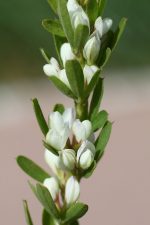 Also called Chinese bush clover, this semi-woody perennial is native to China, Korea, Japan, Formosa, and the Himalayas but was introduced into North Carolina from Japan in 1896 and was planted for erosion control, mine reclamation, and wildlife habitat. Plants have formed dense stands in new and old forest openings, dry upland woodlands, moist savannas, and old fields and has become invasive in New England, Michigan, and Nebraska, south to Florida and Texas. Growing 3-6′ tall from a woody rootcrown with a taproot, the plant has one to many slender branching gray-green stems bearing leaves composed of three narrowly oblong leaflets .4 to .8″ long. Each leaflet is green above with light colored hairs below and is carried on a hairy petiole. From July to September, 1-4 pea like white flowers with a purple throat appear in the upper leaf axils. Each flower is .1 to .3 ” long and has a calyx with 5 long teeth that often turn purplish green. The fruit is a single seeded green pod that turns tan when mature. Chinese lespedeza prefers full sun, average, medium moist to dry, well-drained soil and tolerate lean soil. USDA Hardiness Zones 6-8
Also called Chinese bush clover, this semi-woody perennial is native to China, Korea, Japan, Formosa, and the Himalayas but was introduced into North Carolina from Japan in 1896 and was planted for erosion control, mine reclamation, and wildlife habitat. Plants have formed dense stands in new and old forest openings, dry upland woodlands, moist savannas, and old fields and has become invasive in New England, Michigan, and Nebraska, south to Florida and Texas. Growing 3-6′ tall from a woody rootcrown with a taproot, the plant has one to many slender branching gray-green stems bearing leaves composed of three narrowly oblong leaflets .4 to .8″ long. Each leaflet is green above with light colored hairs below and is carried on a hairy petiole. From July to September, 1-4 pea like white flowers with a purple throat appear in the upper leaf axils. Each flower is .1 to .3 ” long and has a calyx with 5 long teeth that often turn purplish green. The fruit is a single seeded green pod that turns tan when mature. Chinese lespedeza prefers full sun, average, medium moist to dry, well-drained soil and tolerate lean soil. USDA Hardiness Zones 6-8
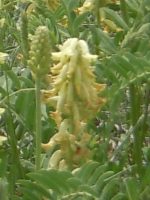
Canada Milkvetch (Astragalus canadensis)
Also known as rattle weed, this herbaceous perennial is native to most of North America where it grows in a variety of habitats including woodlands, prairies, thickets, moist meadows, stream banks, abandoned fields and roadsides. Growing 1-4′ tall from a tap root with rhizomes, the plant has branching stems and pinnately compound leaves that are 5-9″ long and have 21-31 oblong leaflets 1.5″ long. In summer, 6″ long terminal racemes carry up to 75 greenish to cream colored flowers in whorls. Each pea-like flower is tubular, 3/4″ long, and is comprised of 5 petals. The oval seed pod is two chambered, 1/2″ long, and pointed at one end with the remnants of the style adding a tail-like appearance. Nectar provides food for bumblebees and honey bees while the foliage is a food source for wildlife such as wild turkeys, deer, rabbits, and small rodents. USDA Hardiness Zones 3-8
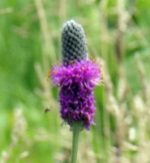 Prairie Clover (Dalea purpurea)
Prairie Clover (Dalea purpurea)
Purple prairie clover is a herbaceous perennial native to central North America from Ontario to Georgia west to Alberta and Arizona where it grows in prairies, savannas, and open woods. Plants grow 1-3″ tall and have multiple stems and pinnately compound dark green leaves with 3-7 narrow leaflets about 1″ long. The small purple flowers are produced on 1-2” cone-like spikes and are accented by golden anthers that extend beyond the petals. The flowers begin to open at the bottom of the cone and form a wreath that gradually moves upward resulting in a long bloom period that extends from mid-summer into fall. The flowers attract bees and the plant is a host plant for sulfur butterfly larva. The plant is anchored by a large taproot making it drought tolerant but difficult to transplant. USDA Hardiness Zones 3-8
Prairie Bundleflower (Desmanthus illinoiensis)
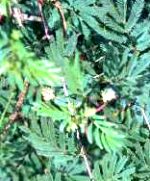 Also called prairie mimosa and prickleweed, this herbaceous perennial is native to the midwestern US where it grows in fields, prairies, riverbanks, and waste areas such as roadsides and train right of ways. Plants grow 1-5′ tall and have a grooved light green stem that is unbranched or sparingly branched. The bipinnately compound leaves are up to 8″ long and have a fern like appearance. The subleaflets are medium to light green, 1/8″ long, and fold together at night. From June to August, clusters of 30-50 white flowers appear on short stems in the axils of the upper leaves. Each flower has long protruding yellow stamens that give a brush like appearance. Clusters of 5-1 dark brown seed pods 1/2″ long follow the flowers. The flowers attract small bees and flies seeking nectar and pollen, the seeds are consumed by gamebirds including pheasant and quail, and the foliage is eaten by various mammals such as rabbits and deer. Because of a high protein content, Illinois bundleflower is considered a valuable range plant. USDA Hardiness Zones 5-8
Also called prairie mimosa and prickleweed, this herbaceous perennial is native to the midwestern US where it grows in fields, prairies, riverbanks, and waste areas such as roadsides and train right of ways. Plants grow 1-5′ tall and have a grooved light green stem that is unbranched or sparingly branched. The bipinnately compound leaves are up to 8″ long and have a fern like appearance. The subleaflets are medium to light green, 1/8″ long, and fold together at night. From June to August, clusters of 30-50 white flowers appear on short stems in the axils of the upper leaves. Each flower has long protruding yellow stamens that give a brush like appearance. Clusters of 5-1 dark brown seed pods 1/2″ long follow the flowers. The flowers attract small bees and flies seeking nectar and pollen, the seeds are consumed by gamebirds including pheasant and quail, and the foliage is eaten by various mammals such as rabbits and deer. Because of a high protein content, Illinois bundleflower is considered a valuable range plant. USDA Hardiness Zones 5-8
Roundheaded Bushclover (Lespedeza capitata)
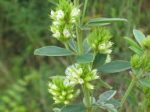 This herbaceous perennnial is native to prairies, meadows, glades, and waste areas such as roadsides from New Brunswwick and South Dakota south to Florida and Texas. Growing from a taproot with long horizontal lateral roots, roundheaded bushclover is 2 t 4″ tall and has erect wiry stems with trifoliate leaves comprised of 3-lobed narrow oblong leaflets up to 3″ long. Both stem and leaves are covered with white hairs. From July to September, axillary globular clusters of small creamy flowers with hairy bracts appear on the upper part of the stems. Each pea-like flower is up to 1/2″ long and has a magenta spot near its throat. USDA Hardiness Zones 3-9 Photo Credit: Wikimedia Commons
This herbaceous perennnial is native to prairies, meadows, glades, and waste areas such as roadsides from New Brunswwick and South Dakota south to Florida and Texas. Growing from a taproot with long horizontal lateral roots, roundheaded bushclover is 2 t 4″ tall and has erect wiry stems with trifoliate leaves comprised of 3-lobed narrow oblong leaflets up to 3″ long. Both stem and leaves are covered with white hairs. From July to September, axillary globular clusters of small creamy flowers with hairy bracts appear on the upper part of the stems. Each pea-like flower is up to 1/2″ long and has a magenta spot near its throat. USDA Hardiness Zones 3-9 Photo Credit: Wikimedia Commons